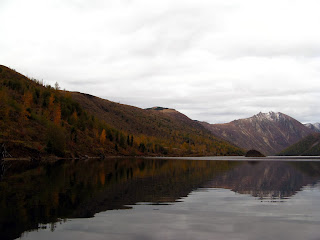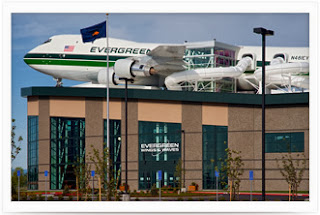Vancouver Island and into the US
It was a beautiful sunny day when we left Vancouver. However,
not for long! The fog rolled in off the Georgia Strait, and soon we were unable
to see anything around us.
 |
| Sunny as we leave |
 |
| But the fog soon began to roll in |
When we got off the ferry, we headed through Nanaimo
to the Living Forest RV Resort.
Many
of the Parks are self-register or choose-your-own-site, outside office hours.
So we drove around and found a pull-through site while we waited for the office
to open. There were several sites overlooking the water; however, they were
booked for the weekend. Many of the people on the Ocean-front and the next
level, the Ocean-view were there for the winter. We decided to stay where we
were.
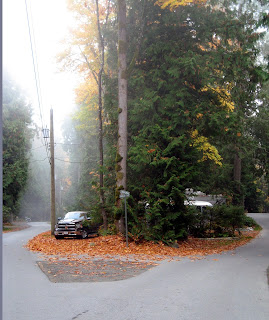 |
| Still fog |
 |
| Lots of prety Maple leaves... |
 |
| Fog cleared about 5, that is the Mainland in the distance |
 |
| But, fog soon came rolling in again |
For the future, note to selves: Don’t set up under deciduous trees in a
windy, foggy, rainy, Pacific northwest rainforest, fall-climate. It was a heavy
fog the first night dripping off the trees, combined with the breeze bringing
the leaves down, it was a musical drumming on the trailer roof all night. The
leaves were piled high on the trailer and solar panel, stuck on with the fog
and rain. The sites behind us, back-in into beautiful fir-treed sites -not a
leaf in sight!
Just up the road, we discovered one of the Island’s best
kept secrets, Serious Coffee. They
have coffee shops all over the Island, but only on the Island, and they make
the best lattes and cappuccinos. They also had wifi, so we became daily
patrons. John contacted his cousin, and we enjoyed a lovely evening catching up
with western family. We explored Nanaimo’s harbour and downtown streets.
 |
| Mural on a building downtown |
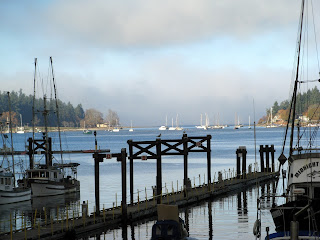 |
| It was fairly clear when we started out - looking through the gap |
 |
| Then the fog started to come in - walking on the Waterfront Trail |
We drove north to see Qualicum Beach
 |
| Tide was out, lots of seaweed and ground fog |
and inland to see
Cathedral Grove. It was foggy and grey in Nanaimo and up the coast. When we got to
Cameron Lake, the sun suddenly appeared,
 |
| Fog at the end of Cameron Lake- We are in the SUN |
and shone for the rest of our visit to
Cathedral Grove
 |
| Underbrush, moss on the trees |
 |
| Some windfall, and tall, tall trees |
 |
| Some trees are bigger than others |
 |
| This is the tallest tree- at 76 metres tall |
and Port Alberni. Usually it is foggy here and sunny on the
coast, but not today. As we drove south, the fog once again covered the coast.
Having had enough of the fog, we headed south. We decided
to stay outside Victoria, at Weirs’ Beach RV Resort. We had a site right on the
water, facing the Strait of Juan de Fuca, and backing onto the lagoon.
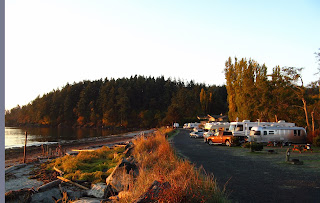 |
| Looking along the line of Waterfront sites |
 |
| Run Around Sue |
 |
| Looking up the beach |
 |
| The lagoon behind us |
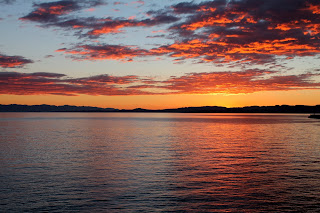 |
| The Strait of Juan de Fuga in front of us |
This is
a clean, friendly resort. There is a clubhouse with a pool table, dart board,
TV, laundry facilities and always a jigsaw puzzle on the go.
 |
| The Clubhouse |
However, it was
several days before we could actually see Victoria from our trailer- more fog!
We spent several days in Victoria. What a beautiful city!
The first visit was around the inner harbour.
 |
| The Empress Hotel |
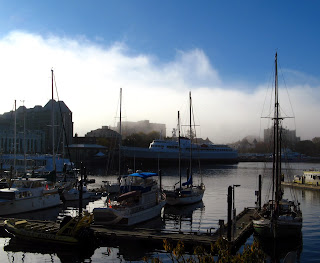 |
| The Inner Harbour |
 |
| Parliament Buildings |
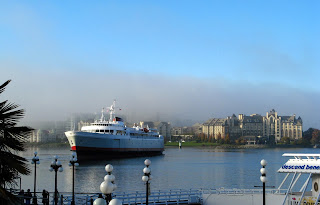 |
| The Coho Ferry to Port Angeles |
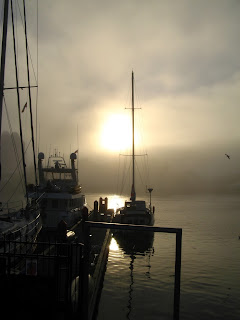 |
| The fog rolled in by late afternoon |
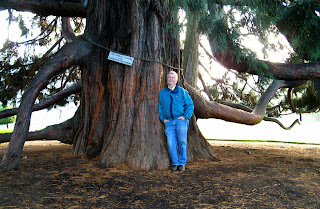 |
| The big fir tree in front of the Parliament Buildings |
One evening we met a friend, had
dinner at her place, and then went down to the harbour to party. Another day we
drove up to Sidney,
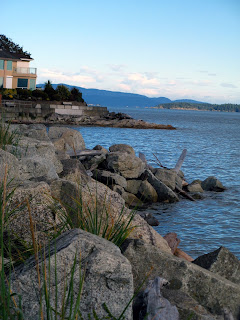 |
| North from Sidney Harbour |
then into Victoria by a different route, parked and
wandered along the waterfront path from the cruise boat docks and around
Fisherman’s Wharf. The houseboats are amazing. Each one is unique.
 |
| The sunset from Victoria, our last evening |
The days were getting cooler and poor weather was
forecast for the next few days, so we decided to head into the U.S. We took the
ferry from Sidney to Anacortes.
 |
| Lined up for the Ferry. We were there 2 hours early |
 |
| Boarding the US Ferry- much cheaper than the BC ferries. |
It was a beautiful ride through the San Juan
Islands,
 |
| The route of the Ferry to Anacortes |
stopping once at Friday Harbour.
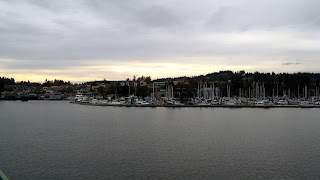 |
| Friday Harbour |
We drove out to I-5 and south. We stayed in Everett at Maple Grove RV Park. It
was rather expensive, at $44 per night plus $5 hotel tax (hotel tax! - WTF [from John]),
but clean and very convenient to all we wanted to do. However, we had some
difficulty getting the Airstream level, and sites are very close together with
low shrubs dividing them.
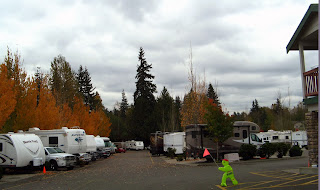 |
| Maple Grove RV Park |
The first thing we did was to find a Costco to get me
a prepaid phone. When we got to Costco we were amazed at the prices of wine.
Robert Mondavi Cabernet Sauvignon came in a box of 4 bottles, and worked out
-with exchange- to be about $5 per bottle [John checked the LCBO listings- it
is 2 ½ times this price]. There were lots of other ‘wine bargains’ for not much
more! We also decided to try some seasoned, fully-cooked lamb shanks. These are
fantastic- 2 to a package, individually wrapped with light gravy- and so easy
to cook, just pop the bag in hot water, keep it just under the boil for 60 min
and eat! When we went back to get more, we also bought the sirloin roast beef-
2 separate packages- open, put in a dish in the oven at 375 for 17 minutes and
eat [and one package is plenty for 2 or 3]. It is rare too! Needless to say,
before we left Washington, we picked up a couple of each. Our frig is full.
Then we had to shop. We could not bring any fruits or
vegetables across the border, so we had to restock, but not in the quantities
Costco offers. So Safeway became our store of choice.
We had booked a tour of the Boeing commercial jet
assembly plant, just a short drive from Maple Grove. The tour was amazing. The hanger is about 8
stories high, with 6 separate bays. Generally an assembly-line technique is
used. In one bay, three 777’s were in the last stages of being assembled. One
was lengthwise having the seats and interior completed, and two were angled at
the other end. In a separate bay, workers were using a completely different
technique to assemble the 787. It is a modular assembly: one section of the
plane is assembled completely on a platform, and then the whole platform moves
to the next station. There is also an interesting series of displays in the Future of Flight Aviation Center with a
lot of extra information on the history of Boeing.
 |
| We couldn't take any pictures inside. The blue doors are the 6 Bays- each a separate assembly unit |
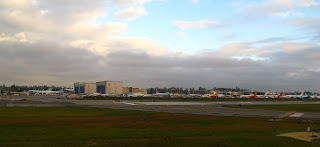 |
| Planes, in front of the paint sheds, painted and lined up waiting to be delivered around the world. |
The next day a dreadful wind and rain storm hit the area.
A lot of areas were without power and had trees down. We were lucky- just more
rain! So we stayed in until the worst was over, and then checked out Everett
Mall and their LA Fitness.
Because there were still a number of areas without power,
we decided to go to the Flying Heritage
Collection. It is a fascinating museum with very knowledgeable volunteers. This
museum traced War II through the planes used and the personal stories of men
and women who flew them. It highlights some of the most important and iconic
military machines of the Second World War. Each plane had a story attached and
the history of that particular plane.
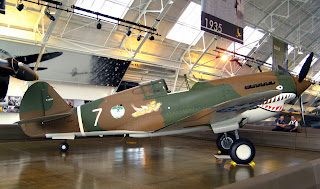 |
| Curtiss P40 Tomahawk |
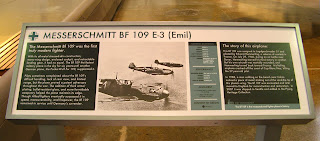 |
| an example of the type of information |
 |
| Russian MiG-29UB Fulcrum |
In a separate building, were WWII tanks
and other artillery.
 |
| the second building |
All artifacts are from the private collection of
philanthropist Paul G. Allen. Each appears just as it did in battle, and most
are functional.
Our last day, we drove into Seattle and saw the
incredible Dale Chihuly exhibition. Words can’t describe his talent and the
beauty of his work.
 |
| This is on a pedestal and almost reaches the ceiling |
 |
| A Ceiling of Glsss |
 |
| The Garden |
 |
| A Float Boat |
 |
| Suspended from the ceiling in a Glass House |
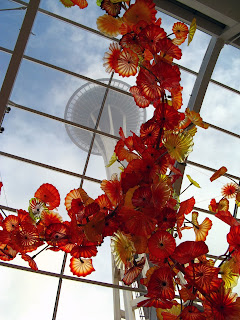 |
| Looking through the Glass House to Seattle's Needle |
 |
| Outside in the Garden |
 |
| A part of the Outside Garden |
We then walked down to Pike Place Market, stopped at the
first Starbucks [but the line was out the door, so we moved on],
 |
| Original Starbucks |
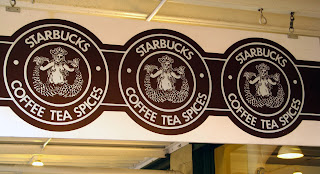 |
| The Original Logo... |
and wandered
around the interesting vendors’ stalls. There is quite a variety- lots of
seafood, crafts, flowers, only one coffee place, restaurants – all on multiple
floors. You walk in at street level, then go down to several more levels!
 |
| There is a string attached to the Monkfish- when someone came close to look at it, one of the men pulled the string, it moved and ... |
We continued south on the I-5 toward Mount St. Helens-
our next stop. I-5 is a great freeway, 4 or 6-lanes divided, but, around Seattle, it often felt as
if we were driving on cobblestones or a corduroy road!







